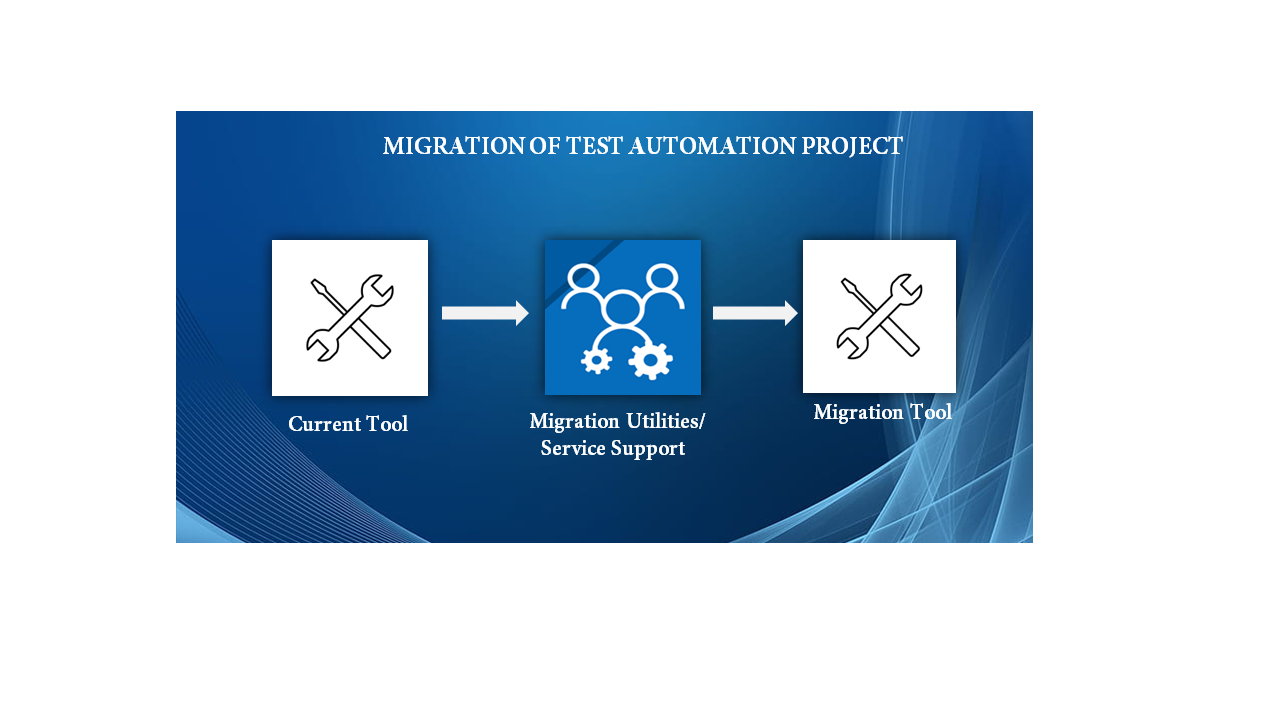Migration of Test Automation Projects
Introduction
Migration of Test Automation Projects refers to the process of transferring or moving existing test automation projects from one automation tool to another. This can transpire for a multitude of factors., such as framework failure or application controls not supported or execution performance is slower, regression maintenance cost/effort is high, or the migration of the application to a new technology has become necessary due to the current tool’s lack of support or the discontinuation of application support by the current tool.
How can one migrate the Test Automation Project?
To successfully migrate test automation project from one tool to another, it is essential to have a deep understanding of the current tool’s architecture, framework structure, features, and capabilities, as well as those of the migration tool. Having this knowledge allows you to identify potential challenges, design appropriate migration strategies, and ensure that the migrated project functions effectively. The migration process can be complex and requires careful planning and execution. Here’s a step-by-step approach to help you begin and complete the migration:
1. Assessment and Planning:
-
-
- Define the objectives: Clearly outline the plan for the migration and the desired outcomes.
- Inventory and analysis: Identify all the supporting plugins of the current tool, configurations, dependencies, and data requirements and also understand it’s purpose in the existing tool that need to be migrated to the new tool.
- Set migration strategy: Determine the approach to migration, from where to begin and how to move step by step and finally how to complete.
- Establish timelines and milestones: Create a migration plan with specific timelines and milestones to track progress and ensure accountability.
-
2. Design and Preparation:
-
-
- Input Data Migration: Determine the way to migrate the input test data format from current tool to migration tool.
- Object Repository (OR): Identify a way to convert the existing OR format to the new tool.
- Methods/Functions: Determine the way to find out the equivalent Methods/Functions of current tool to the new tool.
- Tests: Determine the format to convert all the existing tests from one tool to Migration Tool.
- Plan/Suite: Group the plan/Suite in the same way as per the current tool .
- Supported Dependencies and Plugin/Any Other: It is essential to carefully assess and identify the equivalent dependencies or plugins in the new tool that perform the same tasks or provide similar support as those used in the current tool.
-
3. Develop and Migrate:
-
-
- Utilities needs to be built for developing the format or converting the data/code for all the mentioned items in the design phase.
- To ensure consistent output in the new tool, these utilities must be meticulously constructed and adapted.
- Develop all the code/scripts with the help of utilities as per the new tool.
- Some of the utilities require help from the migration tool side.
- All syntax errors are resolved, and the migrated code is prepared for execution.
-
4. Backup and Contingency:
-
-
- Backup Data: Before the actual migration, take full backups of the data and configurations of the existing tools to ensure data safety.
- Develop contingency plans: Prepare backup plans in case the migration encounters unexpected problems. This might involve identifying rollback procedures or alternative solutions. For this use any source control.
-
5. Migration Execution:
-
-
- Implement the Migration: Proceed with the execution of the migration code, diligently adhering to the planned steps to ensure a smooth and successful migration process.
- Monitor Progress: Continuously monitor the execution of migration tests to identify and address any potential issues in real-time. It resolves all the runtime issues.
- Migration Success: This execution demonstrates an equal or greater number of passed tests compared to the current tool, indicating a successful migration and ensuring the application’s functionality is maintained or enhanced in the new version of the application.
-
6. Post-Migration Verification:
-
-
- Validate the migration: After the migration execution is complete, verify that the tests are functioning correctly in the new tool on the said environment.
- User acceptance testing: Involve end-users in testing to ensure that the migrated tests meet their requirements and expectations.
-
7. Training and Support:
-
-
- Provide Training: Offer training and support to Client to help them adapt to the new migrated tests.
- Address issues and feedback: Address any post-migration issues or feedback from users and stakeholders promptly on the naming conventions, coding guidelines.
-
8. Optimization and Continuous Improvement:
-
-
- Optimize performance: Fine-tune the migrated tests performance to ensure they operate efficiently in the new tool.
- Review and learn: Conduct a post-migration review to gather insights and learn from the process, making improvements for future migrations.
-
9. Documentation:
-
-
- Document the migration process: Create a high-level documentation of the migration steps, configurations, and any specific considerations
-
When Migration is Successful?
A migration of regression test automation projects is deemed successful when it meets the predefined objectives and requirements, and it satisfies the following criteria in full:
-
-
- Functionality: The success of the migration relies on the migrated tests performing their intended validation as expected in the new tool, ensuring all test flows function correctly, and preserving full functionality without any loss.
- Input Data:During the migration process, it is essential to ensure that the input data transferred from the existing tool to the new tool retains its original values and is seamlessly passed to its respective tests. A successful migration should safeguard against any data loss, corruption, or inconsistencies in the process.
- Performance:The performance of the migrated tool should meet or exceed the performance levels of the previous tool. There should be no significant degradation in response times.
- Test Execution Results:Number of passed tests in the migrated tool should be equal or greater than the tests passed before migration.
- Scalability:The migrated tool should be able to handle increased tests and accommodate future tests as needed and work with the same or increased performance.
- User Acceptance: End-users should be satisfied with the migrated tests performance and usability. Their feedback should be positive, and any identified issues should be promptly addressed.
- Cost and Budget: The migration of tests should be completed within the allocated budget and should not result in unexpected or excessive costs.
-
Advantages of Migrating Automation Projects:
-
-
- Enhanced Performance: Migrating to newer or more advanced tools can lead to improved performance and efficiency. Newer tools often come with updated features, better optimization, and increased capabilities, leading to faster and more reliable results.
- Cost Savings: Migrating projects to new tools can help reduce development and maintenance costs. Modern/New tools are often designed to be more cost-effective in terms of maintenance, licensing, and support. Additionally, they might require fewer resources to achieve the same outcomes in a short span within 3-6 months, resulting in greater cost savings.
- Increased Features: As technology evolves migrating to newer tools can provide better features and increases productivity.
- Scalability: Newer tools are usually designed with scalability in mind. They can accommodate the growth of your regression tests and handle larger suites without compromising performance.
- Compatibility and Integration with CI/CD: Migrating to modern tools can improve compatibility with other software Plugins. This can facilitate smoother CI/CD integration between different tools and technologies, leading to a more cohesive and efficient test execution.
- Access to New Features: Upgraded tools often introduce innovative features and functionalities that were not available in the existing tools. These new capabilities can enable users to achieve tasks that were previously impossible or required third-party solutions.
- Vendor Support: Existing tools might reach end-of-life, leading to discontinued vendor support and updates. Migrating to supported tools ensures that you receive ongoing assistance, bug fixes, and updates from the vendor.
- Future-Proofing: By staying up-to-date with the latest tools and technologies, you position yourself or your organization to remain competitive in the ever-changing digital landscape.
-
Risks:
-
-
- Disruption to Testing Process: During the migration process, there might be a period of disruption to the testing process, leading to delays in testing cycles and project timelines.
- Compatibility Issues: The migrated test automation project with the help of utilities may not be fully compatible with the existing test scripts, frameworks, or the application under test. This can result in the need to rewrite or modify existing test scripts, leading to increased effort and time.
- Skill Gap and Training: Test automation teams might be accustomed to the old tool and might lack the necessary skills or knowledge to effectively use the new tool. Adequate training and upskilling are essential to ensure a smooth transition.
- Data Migration and Management: If the test automation tool relies on test data stored in the old tool, transferring and managing the data in the new tool can be challenging and may result in data discrepancies or loss.
- Tool Functionality and Features: The new tool functionalities and features may not perform in the same manner as present in the old tool. It is crucial to evaluate whether the essential testing requirements are adequately supported by the new tool.
- Tool Performance and Stability: The new test automation tool might have performance or stability issues, leading to test failures or unreliable results.
- Integration with Other Tools: Test automation tools often need to integrate with other software development tools, such as CI/CD pipelines and bug tracking systems. Ensuring smooth integration is critical to maintain the efficiency of the testing process.
- Validation and Verification of Results: There is a risk of discrepancies between the results obtained from the old tool and the new tool during the migration. It is essential to validate and verify the accuracy of test results.
- Cost and Licensing: The cost of the new tool, including licensing fees, might be higher than the existing tool. Proper cost-benefit analysis is necessary to ensure that the benefits outweigh the expenses.
- Resistance to Change: Testers and other stakeholders involved in the testing process may resist the change, especially if they are comfortable with the existing tool and processes.
-
Conclusion:
- In conclusion, migration of Test Automation Project from existing tool to a new tool can bring numerous benefits to the organizations. Upgrading to newer and more advanced tools can lead to enhanced performance, cost savings, increased security, scalability, better compatibility, and access to new features. Additionally, user-friendly interfaces, ongoing vendor support, improved collaboration, and future-proofing are among the advantages of tool migration.
Strategic Migration Considerations:
- Your entire automated test projects which took over 3-5 years (Approx) to build your regression suites can be migrated within *3-6 months based on the number of tests involved in the project which not only saves cost but also time and effort which cannot be valued as it helps you for a quick market release of the product. Think thrice before you change the automation tool to start again the existing project from scratch as migration is the best solution available.
Critical Steps and Considerations for Seamless Test Migration:
- However, successful migration of tests requires careful planning, thorough conversions of Object Repository, Functions, Data, Tests and Plans/Suites, and fixing of all syntax and runtime issues to ensure a smooth execution. It is essential to evaluate the specific needs and requirements of your organization before proceeding with the migration of automation project.
Growth Through Strategic Automation Migration:
- Ultimately, embracing migration of automation project as a strategic decision can empower you or your organization to stay competitive, adapt to technological advancements, and achieve higher levels of productivity and efficiency. By leveraging the advantages of tool migration, you can optimize your operations and position yourself for continued growth and success in the ever-evolving digital landscape.
Migration Whitepaper Links:
***Coming soon on Ranorax and TestComplete.
Migration Video Links:
-
-
- Sample Selenium to AscentialTest Migration
-
Queries
For any information/query on Migration of Test Automation Projects,
Please contact us at [email protected].
For more details visit www.matryxsoft.com





